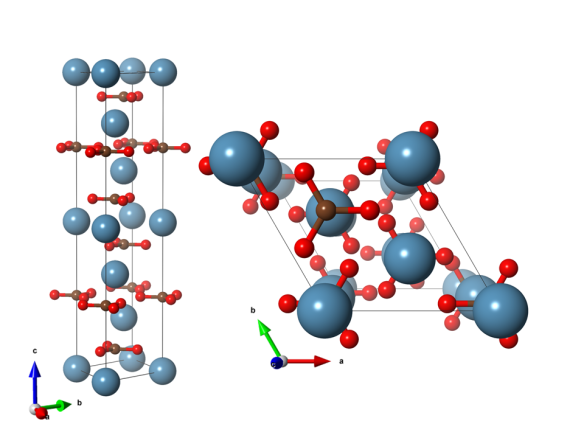Seeing Double – Calcite
What does it look like?

Image generated using CrystalMaker: http://www.crystalmaker.com
The calcite structure is made up of just three atoms, calcium (blue), carbon (brown) and oxygen (red). The structure consists of calcium (Ca2+) cations sandwiched between flat layers of carbonate (CO32-) anions.
What is it?
Calcite is the most common mineral form of calcium carbonate, CaCO3. It is commonly found in sedimentary rocks and forms the primary component of marble as well as the shells of many marine creatures such as plankton and oysters. Calcite crystals can take many forms; however one very specific type, Iceland spar has played a very important role in the development of the science of optics. This transparent form has a remarkable property known as double image refraction or birefringence – when you look through Iceland spar, everything is doubled.
As light strikes Iceland spar it is split into two beams of polarised light. These two beams travel at different speeds through the crystal and are therefore bent by two different angles of refraction, creating the two images.
Christiaan Huygens and Isaac Newton both studied Iceland spar as part of their attempts to understand the true nature of light, and both modified their competing theories to account for the doubly refracting behaviour.[1]
Until well into the 20th century all examples of this mineral came from just one mine at Helgustadir in Eastern Iceland. It now seems likely that this extraordinary mineral played an important role in Viking history. Medieval texts from Iceland talk of 'sunstones' used to find the direction of the sun for navigation, even on the rough cloudy seas of the North Atlantic.[2] After the discovery of a large crystal of Iceland spar in the wreck of the Elizabethan English ship the Alderney it seems almost certain that these mythical sunstones were large clear crystals of calcite.[3]
Where did it come from?
The crystal structure of calcite was one of the earliest structures to be solved, as early as 1920 by Wyckoff. The structure used for the images above is available in the Open Crystallography database # 2100992.
[1] Chambers, Ephraim, ed. (1728) Cyclopaedia, or an Universal Dictionary of Arts and Sciences
[2] Karlsen, Leif K. (2003) Secrets of the Viking Navigators, One Earth Press
[3] First evidence of Viking-like 'sunstone' found. Livescience.com. Accessed 12 February 2013.






